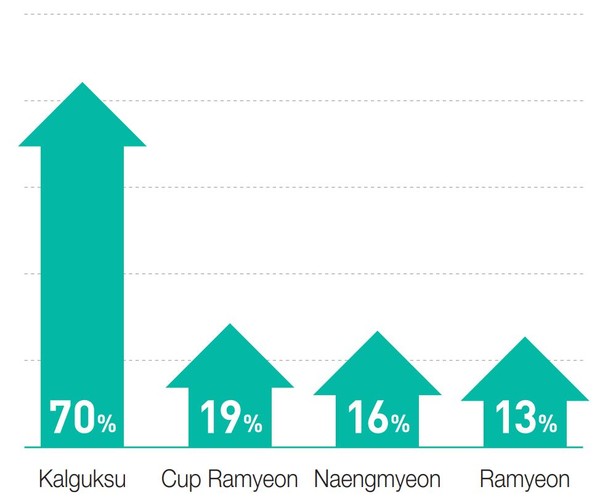As COVID-19 has died down, you have likely gone out to lunch. Have you been shocked by the lunch prices? This recent rise in lunch prices is called lunchflation. Lunchflation is a newly coined word that combines lunch and inflation. Namely, it refers to a situation in which students’ and workers' lunch spending has increased due to inflation.
- JBNU Students’ Experiences and Countermeasures
When did JBNU students start to feel the effects of lunchflation? What was their countermeasure? The JBNU Globe interviewed four anonymous students with these questions.
A: “Since the first semester of 2022, the amount of offline classes have really increased, so I often had lunch with friends. On weekends, I was able to save money by going to an inexpensive restaurant. However, I was frequently dissatisfied because I ate similar foods every weekend.”
B: “In March, I ate out almost every day, and my expenses increased. When I had to order food, I used discount coupons provided by the delivery app. I sometimes ate lunch at a discounted price by using the convenience store’s lunch box subscription service. When I had extra time, I bought the ingredients and cooked. In the end, I saved about fifty thousand won per month from the money that I used to spend eating out. I was also able to use my time more efficiently because I could have a quick lunch and do homework in my spare time. That was another advantage of not eating out.”
C: “Since last year, school club activities have become more frequent, so I used to eat lunch using a food delivery app. Yet this year I've been trying not to use it and I eat at home, so I've saved a lot of lunch money compared to last year. I like delivery food that I can eat comfortably at home, but considering the price, menu options are limited. It was another downside.”
D: “Since the delivery fee has increased during the COVID-19 situation, it became too expensive to order delivery food. On days when I was starving, I went to a convenience store or an inexpensive restaurant. When I wanted more delicious food, I went to a restaurant for take-out food. As a result, I saved about fifty thousand won per month, but I became weak because I could not get enough nutrients. With the money I saved, I bought nutritional supplements such as vitamins, consumed them regularly, and exercised at the same time. Now, I feel healthier than I did before.”
- Convenience Stores Carry Out Strategy to Expand Their Convenience Food Promotion

People started looking for cheap food such as instant and food from convenience stores because of lunchflation. Sales of convenience store foods such as cold noodles, noodles, and ramen have increased significantly in recent months. Food sales have increased as of May 2022, in stark comparison to the same month last year. Consumers have been looking for a lunch box. According to <<New Daily>>, sales of lunch boxes from convenience stores have increased by 27.1% year after year. In addition, the sales showed an upward trend of 28.0% for triangular kimbap, 23.7% for kimbap, and 19.3% for sandwich. Convenience store brands showed examples of marketing aimed at lunchflation. CU conducted a simple food payment discount promotion. Customers could get a 30% discount if they paid with a Samsung card, Payco, or Naver Pay for twenty foods including lunch boxes and cup noodles. This promotion is highly popular because people can purchase popular products at reasonable prices. 7-Eleven also launched kimbap and fried rice in collaboration with JONGGA, reflecting the growing popularity of simple meals.
- Restaurant Owner around JBNU Speaks Out About Lunchflation

Lunchflation has prompted students to look for inexpensive restaurants. At Leeyoun Guksu (noodle), located near the JBNU Hospital, most items are 4,500 won or less. The JBNU Globe interviewed the owner of Leeyoun Guksu about lunchflation.
Kim Chang-young: “I have been running this restaurant for thirty years, and a month ago, the prices of all the items were increased by 10%. The reason is because of the rise in flour prices. My iron rule in restaurant management is ‘sell a lot of good food at a low price’. This is how customers can be most satisfied and how I can make a profit. It seems that keeping this iron rule is highly appreciated due to inflation. For powerless business owners like me, inflation is as painful as war. We have no influence; we have no choice but to accept the situation. There is nothing we can do about it. It's a pity that the students seem to be eating poor meals due to lunchflation. For this reason, I advise students to look for restaurants that sell high-quality food with reasonable prices. I believe that high-quality and inexpensive food made in a restaurant is much more beneficial to students in many ways than convenience store food, which has large amounts of preservatives.”

This is a graph showing the growth rate of convenience food sales. Sales of May 2022 and May 2021 were compared. Data for Naengmyeon(cold noodle) and Kalguksu(noodle soup) were provided by CJ CheilJedang, data for Ramyeon by Nongshim. |
The Bank of Korea estimates that the inflation rate of 2022 is highly likely to exceed the previous estimate of 4.5%. Therefore, lunchflation will continue for the time being. The future looks dim, but we still have to soldier on and eat our lunch. How many more ‘problems’ and ‘solutions’ will emerge in lunchflation, which hits students the hardest?
| Ha Yae-one Reporter, Yang Seo-jung Cub-Reporter

